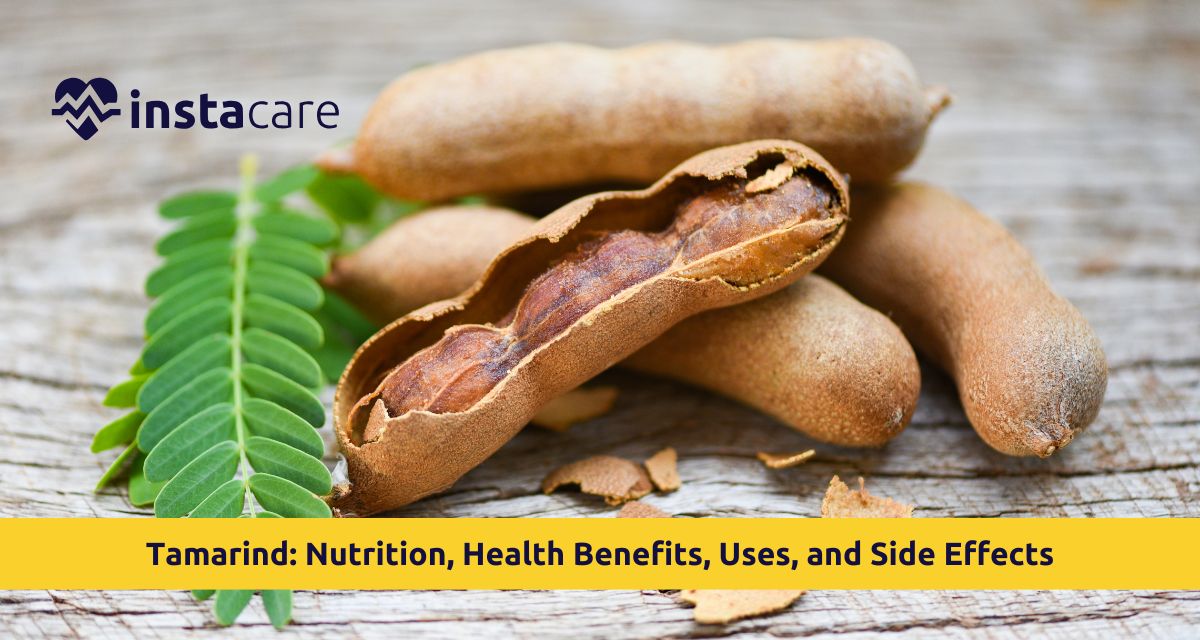But tamarind is only a spice. It's an antioxidant and health-beneficial natural chemicals condensed food. It is also, centuries back, traditionally used in medicine to cure digestive disease, fever, skin disease, and infection. Most importantly all those health foods nowadays have science backing them. Tamarind nutrition facts, tamarind fruit benefits, and tamarind side effects will inform you about the application of this fruit in your life.
What is Tamarind?
Tamarind is derived from the plant tree Tamarindus indica African but widely spread in Asia, India, and other tropics. The pod contains brown sticky pulp within it, which is sour to sweet.
The taste of tamarind varies according to the fruit's ripeness:
- Unripe tamarind is sour and acidic and is utilized very often in curries or soups.
- Fully grown tamarind has a sweet flavor and is used quite often in sweets, chutneys, and sauces.
Tamarind comes in different forms: tamarind paste, juice, concentrate, dried blocks, or raw pods. Convenience of use in domestic medication, Tamarind in cooking, and beverages.
Nutritional Profile of Tamarind
What the fruit's nutrients communicate is sufficient to realize why tamarind is food and medicine. Around 100 grams of tamarind pulp will provide you with roughly:
- Calories: 239 kcal
- Carbohydrates: 62 grams
- Dietary Fiber: 5 grams
- Protein: 2.8 grams
- Fat: 0.6 grams
- Vitamin C: 3.5 milligrams
- Vitamin B1 (thiamine): 0.43 milligrams (36% daily value)
- Magnesium: 92 milligrams (23% daily value)
- Potassium: 628 mg (13% daily value)
- Calcium: 74 mg
- Iron: 2.8 mg
Key Nutritional Data
- High fibre content: Easy digestability.
- Rich in minerals: Potassium, magnesium, and calcium for bone and heart health.
- Antioxidant content: Flavonoids and polyphenols are helpful in averting cell damage.
- Energy content: Natural sugar content gives instant energy boost.
All these are responsible for all the goodness which tamarind fruit can provide once individuals make it a part of their foods.
Health Benefits of Tamarind
1. Tamarind for Digestion
Tamarind for digestion is also a home cure. Its fiber causes an end to suffering from constipation, and acids in it stimulate digestive juices. Tamarind juice or tamarind tea that dissolves bloating and stimulates bowel movement needs to be consumed.
2. Tamarind for Weight Loss
There is very little evidence that Tamarind for weight loss is affective. Tamarind contains hydroxycitric acid (HCA), which suppresses appetite to stop fat storage. There is no such magic pill with tamarind, but taking tamarind water or eating tamarind with food can be another healthy food and lifestyle option.
3. Heart Health
The tamarindo contains within it the magnesium and the potassium that aid in heart rate and blood pressure regulation. As per research, tamarind lowers LDL or "bad" cholesterol and raises HDL or "good" cholesterol; thus, when consumed daily, it could be heart-friendly.
4. Tamarind for Skin
Tamarind pulp is a reservoir of natural alpha-hydroxy acids (AHAs), which are soothing peel-off treatments. Tamarind for skin face packs remove dead skin, fade dark marks, and provide glow. Its antioxidants slow down age signs as well.
5. Tamarind for Hair
Application of tamarind water or paste over the hair can make the hair strong, reduce dandruff, and promote growth. Tamarind for hair nutrients feed the hair roots and bring about a healthy scalp.
6. Tamarind Tea Benefits
Tamarind tea is a calming beverage made with hot water and blended in it by the assistance of tamarind pulp, occasionally ginger and honey. Tamarind tea soothes digestion, maintains the immune system intact, and serves as a natural purifier.
7. Tamarind Seeds Benefits
The seeds, rather than being wasted, are nutritionally valuable. Tamarind seeds benefits are already used in Ayurveda as conventional medicine by roasting them in an effort to reduce joint pains, facilitate blood sugar control, and boost immunity. The seed extracts contain antioxidant and anti-inflammatory activities.
8. Tamarind Juice Benefits
Tamarind juice has health benefits in a glass cools down and is an electrolyte-retaining beverage as well. It will cool the body, ease fatigue, and rehydrate, particularly in the summer.
9. Tamarind in Traditional Medicine
There are a number of applications of tamarind in traditional medicine:
- Ayurveda cools the digestion, prevents inflammation, and cool the body with tamarind.
- Traditional African medicine treats fever, diarrhea, and infection using tamarind.
- Tamarind beverages are said to energize a person and cleanse the body in Latin America.
Tamarind Side Effects
All the virtues tamarind performs on the body aside, an excess of what is good comes with tamarind side effects including:
- Stomach discomfort: Excess use of tamarind leads to diarrhea or cramps.
- Mouth issues: Acidity is responsible for wear on the enamel, especially when consumed in the form of candy or juice.
- Blood sugar reduction: Tamarind reduces blood sugar, and therefore caution in its use by diabetics.
- Drug interaction: Augments anticoagulant effect, thus more chance of bleeding.
- Allergy: Rarely, but sometimes individuals become allergic with the outbreak of skin and itching.
Moderation is the key to tamarind, use tamarind but moderately.
How to Use Tamarind in Your Food?
Tamarind is highly versatile. Here are some delicious ways of using it with your food:
Uses of Tamarind Paste
- Tamarind paste uses To provide sourness to curries, stews, or soups.
- Add to meat or fish marinades.
- As an ingredient in chutneys, dips, or sauces.
Tamarind in the Kitchen
- Standard ingredient in Indian dishes such as sambar, rasam, and tamarind rice.
- To balance Thai pad thai and Thai soups.
- Mixed with water to make Mexican candies, aguas frescas (tamarind water), and sauces.
Tamarind Recipes
- Tamarind Chutney: Sweet-sour sauce to accompany snacks.
- Tamarind Rice: Spice South Indian dish using tamarind paste and spice.
- Tamarind Candy: Mix pulp, sugar, and chili to make sweet-spicy dish.
- Tamarind Juice: Mix pulp with water, sugar, and salt to make healthy drink.
Other Ideas
- Use tamarind tea for digestion.
- Use tamarind pulp for smoothie for sour flavor.
- Use it as a lemon or vinegar substitute as a natural preservative.
Conclusion
Tamarind is digestible and full of medicinals as well. It helps digest food, reduce weight, and your hair, skin, and heart. So people eat it as food and medicine all over the globe. But beware that overeating tamarind gets you into trouble. It will flip your stomach over or kill tooth enamel. But eating it in moderation is healthy and not poisonous.
You can consume tamarind as a beverage, Tamarind recipes, orally, or even in home remedies. It tastes good and is nutritious for you. With ages of experience in traditional medicine and contemporary nutrition, tamarind really is a great superfood.
Please book an appointment with the
best Nutritionist in Lahore, Karachi, Islamabad, and all major cities of Pakistan through
InstaCare, or call our helpline at 03171777509 to find the verified doctor for your disease.

